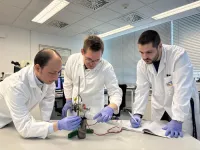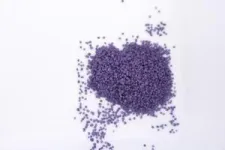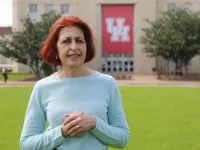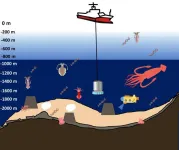(Press-News.org) It is one of the most significant trends in materials science: materials that consist of only a single layer of atoms, so-called “2D materials”, often show completely different properties than thicker layers consisting of the same atoms. This field of research began with the Nobel Prize-winning material graphene. Now, research is being conducted into the material class of MXenes (pronounced Maxenes), which consist mainly of titanium and carbon, by TU Wien (Vienna) together with the companies CEST and AC2T.
These MXenes have properties that sound almost miraculous: they can be used for electromagnetic shielding, for energy storage or for novel sensors. At TU Wien, it was found that they are also amazingly suitable as solid lubricants, even under the harshest conditions, for example in space technology. The only problem so far has been that producing these MXenes was considered extremely dangerous and toxic. But now a new method has been developed: instead of a toxic acid, electricity is used. The new synthesis method has now been published in the renowned journal Small.
No more toxic hydrofluoric acid
“To produce MXenes, you first need so-called MAX phases. These are materials that can consist, for example, of layers of aluminium, titanium and carbon”, explains Pierluigi Bilotto from the Research unit of Tribology at the Institute of Engineering Design and Product Development at TU Wien. “Until now, hydrofluoric acid was used to etch away the aluminium in the MAX, which then resulted in a system of atomically thin layers that can slide against each other with very little resistance. This makes these MXenes a great lubricant.”
But handling hydrofluoric acid is no easy task. It is toxic and harmful to the environment, and there are strict regulations on how to handle this chemical. You need special, expensive laboratory equipment for it, and you get waste products that have to be disposed of in a costly way. “This is why MXenes have not yet made a major breakthrough in industry,” says Pierluigi Bilotto. “It's hard to build up such a process on an industrial scale, and many companies understandably shy away from taking this step.”
So Pierluigi Bilotto set out to find a better method – together with Prof. Carsten Gachot and Prof. Markus Valtiner from TU Wien, Dr. Markus Ostermann from CEST in Wiener Neustadt, Marko Pjlievic from AC2T and others.
Electrochemistry
“Electrochemistry offers an alternative route to break the aluminium bonds in the MAX phase, ” says Pierluigi Bilotto. “When an electrical voltage is applied, the MAX phase experiences an electric current that initiates reactions at its interfaces. By precisely selecting the voltage, we are able to tune the reactions in a way that only Aluminium atoms are removed, leaving as product electrochemical MXenes (EC-MXenes).
The team found that a very specific electrochemical technique can be used to improve the electrochemical etching and EC-MXene’s overall quality: well-dosed pulses of current. While the reactivity of the surface often drops quickly with other methods, short current pulses cause small hydrogen bubbles to form on the MAX phase materials, cleaning and reactivating the surface. This allows the electrochemical reaction to be sustained for longer periods of time and a large quantity of EC-MXenes to be produced.
The product obtained was then analysed with advanced techniques such as Atomic Force Microscopy, Scanning and Transmission Electron Microscopy, Raman and X-ray Photoelectron spectroscopy, and Low Energy Ion Scattering. – its properties are at least as good as those of MXenes previously produced using hydrofluoric acid. “My goal is to make the synthesis of MXene extremely simple. It should be possible in any kitchen”, says Pierluigi Bilotto. “And we are very close to that.”
END
New, non-toxic synthesis method for “miracle material” MXene
The nanomaterial MXene is used for battery technology or as a high-performance lubricant. Until now, its production was difficult and toxic. New methods have been developed at TU Wien.
2025-04-14
ELSE PRESS RELEASES FROM THIS DATE:
Cutting-edge optical genome mapping technology shows promise for diagnosis, prognosis, and therapeutic options of multiple myeloma
2025-04-14
Philadelphia, April 14, 2025 – Researchers have demonstrated the potential of the innovative optical genome mapping (OGM) technique for the diagnosis, prognosis, and therapeutic management of multiple myeloma. This new study in The Journal of Molecular Diagnostics, published by Elsevier, details how this novel method can establish the cytogenomic profile of the tumor on a scale suitable for routine practice in cytogenetics laboratories.
Multiple myeloma, a type of blood cancer that forms in plasma cells (a type of white blood cells), is the second ...
Study looks at impact of COVID-19 pandemic on rates of congenital heart disease procedures among children
2025-04-14
Major reallocation of healthcare services during the COVID-19 pandemic meant that elective surgery in children with congenital heart disease (CHD) was significantly reduced, so that those needing urgent, lifesaving and emergency surgery could be treated. However, this prioritisation of the most severely ill children did not increase overall post-operative complications rates or death, a study led by the University of Bristol has shown.
The research, published in Open Heart, suggests that prioritising surgery for younger and more critically ill children may be appropriate when there is a sudden disruption of usual care. The ...
UH researcher unveils new model to evaluate impact of extreme events and natural hazards
2025-04-14
When you’re on a sandy beach or the banks of a river, transformed by rolling waves or slightly still waters, it’s likely you’re not thinking about what happens just beneath the surface, where dirt and pollution are swirling and traveling through to new destinations.
But Hanadi Rifai does. The Moores Professor of Civil and Environmental Engineering and director of the Hurricane Resilience Research Institute, has spent two decades examining Galveston Bay – its tides, currents ...
Illegal poisonings imperil European raptors and could disrupt ecosystem health
2025-04-14
A recent comprehensive assessment on the poisoning of raptors across Europe does not yield good news. This is according to the new paper “Poisoning in Europe Between 1996 and 2016: A Continental Assessment of the Most Affected Species and the Most Used Poisons,” published in the Journal of Raptor Research. A large team of raptor researchers amassed retrospective data on poisoning events across 22 European countries between 1996 and 2016. Carbofuran and aldicarb were the most common toxins reported and disproportionately affected scavenging raptors, especially in Northern ...
UF professor develops AI tool to better assess Parkinson’s disease, other movement disorders
2025-04-14
A University of Florida researcher has developed a groundbreaking open-source computer program that uses artificial intelligence to analyze videos of patients with Parkinson's disease and other movement disorders. The tool, called VisionMD, helps doctors more accurately monitor subtle motor changes, improving patient care and advancing clinical research.
Diego Guarin, Ph.D., an assistant professor of applied physiology and kinesiology in UF’s College of Health and Human Performance, created the software to address the potential risk of inconsistency ...
Computer science professor elected AAAS Fellow
2025-04-14
Dr. Latifur Khan, professor of computer science at The University of Texas at Dallas, has been elected to the 2024 class of American Association for the Advancement of Science (AAAS) fellows.
Khan is one of 471 scientists, engineers and innovators to be recognized across 24 disciplinary sections. The new fellows will be honored at a June 7 event in Washington, D.C.
The AAAS elected Khan in the section on information, computing and communication for “distinguished contributions to the field of machine learning with applications to cybersecurity, social sciences ...
Learning about social interaction by studying dancing
2025-04-14
Dancing fluidly with another involves social coordination. This skill entails aligning movements with others while also processing dynamic sensory information, like sounds and visuals. In a new JNeurosci paper, Félix Bigand and Giacomo Novembre, from the Italian Institute of Technology, Rome, and colleagues report their findings on how the brain drives social coordination during dance.
The researchers recruited pairs of inexperienced dancers and recorded their brain activity, whole-body movements, and ...
Immune cell 'messengers' could save crumbling bones - new hope for joint pain sufferers
2025-04-14
A recent study has uncovered a potential breakthrough in treating osteonecrosis of the femoral head (ONFH), a debilitating bone disease that causes severe pain and joint collapse. Researchers have discovered that exosomes derived from M2 macrophages-derived exosomes (M2-Exos) can significantly improve bone regeneration by modulating neutrophil extracellular traps (NETs) and endothelial cell function. These tiny vesicles, packed with miR-93-5p, were shown to reduce harmful NETs formation and enhance ...
Fishing for cephalopod DNA allows for efficient marine surveying
2025-04-14
New DNA probes allow for efficient surveying of the hidden lives of squids and octopuses in the deep sea. This development by Kobe University provides an effective tool for marine ecological research and conservation efforts.
Squids and octopuses eat and are eaten, and in between that they move around a lot. “Cephalopods play an important role in marine ecosystems, contributing to the distribution of energy and nutrients in the food web,” explains Kobe University marine ecologist WU Qianqian. And while for ecological research it is therefore essential to know about the distribution ...
Having a 'therapist in your pocket' curbs depression among primary care patients
2025-04-14
Patients with depression who received the Moodivate app saw clinically meaningful reductions in their symptoms that were twice those achieved with standard-of-care therapy in a clinical trial conducted at 22 primary care practices in Charleston, South Carolina. App users were also 3 times more likely to achieve a clinically meaningful improvement in their depression and 2.3 times more likely to attain depression remission. Moodivate (available on both iOS and Android) is a digital version of behavioral activation, a type of behavioral therapy that has proved effective against depression. Jennifer Dahne, Ph.D., professor in the Department of Psychiatry and Behavioral ...
LAST 30 PRESS RELEASES:
Why nail-biting, procrastination and other self-sabotaging behaviors are rooted in survival instincts
Regional variations in mechanical properties of porcine leptomeninges
Artificial empathy in therapy and healthcare: advancements in interpersonal interaction technologies
Why some brains switch gears more efficiently than others
UVA’s Jundong Li wins ICDM’S 2025 Tao Li Award for data mining, machine learning
UVA’s low-power, high-performance computer power player Mircea Stan earns National Academy of Inventors fellowship
Not playing by the rules: USU researcher explores filamentous algae dynamics in rivers
Do our body clocks influence our risk of dementia?
Anthropologists offer new evidence of bipedalism in long-debated fossil discovery
Safer receipt paper from wood
Dosage-sensitive genes suggest no whole-genome duplications in ancestral angiosperm
First ancient human herpesvirus genomes document their deep history with humans
Why Some Bacteria Survive Antibiotics and How to Stop Them - New study reveals that bacteria can survive antibiotic treatment through two fundamentally different “shutdown modes”
UCLA study links scar healing to dangerous placenta condition
CHANGE-seq-BE finds off-target changes in the genome from base editors
The Journal of Nuclear Medicine Ahead-of-Print Tip Sheet: January 2, 2026
Delayed or absent first dose of measles, mumps, and rubella vaccination
Trends in US preterm birth rates by household income and race and ethnicity
Study identifies potential biomarker linked to progression and brain inflammation in multiple sclerosis
Many mothers in Norway do not show up for postnatal check-ups
Researchers want to find out why quick clay is so unstable
Superradiant spins show teamwork at the quantum scale
Cleveland Clinic Research links tumor bacteria to immunotherapy resistance in head and neck cancer
First Editorial of 2026: Resisting AI slop
Joint ground- and space-based observations reveal Saturn-mass rogue planet
Inheritable genetic variant offers protection against blood cancer risk and progression
Pigs settled Pacific islands alongside early human voyagers
A Coral reef’s daily pulse reshapes microbes in surrounding waters
EAST Tokamak experiments exceed plasma density limit, offering new approach to fusion ignition
Groundbreaking discovery reveals Africa’s oldest cremation pyre and complex ritual practices
[Press-News.org] New, non-toxic synthesis method for “miracle material” MXeneThe nanomaterial MXene is used for battery technology or as a high-performance lubricant. Until now, its production was difficult and toxic. New methods have been developed at TU Wien.








